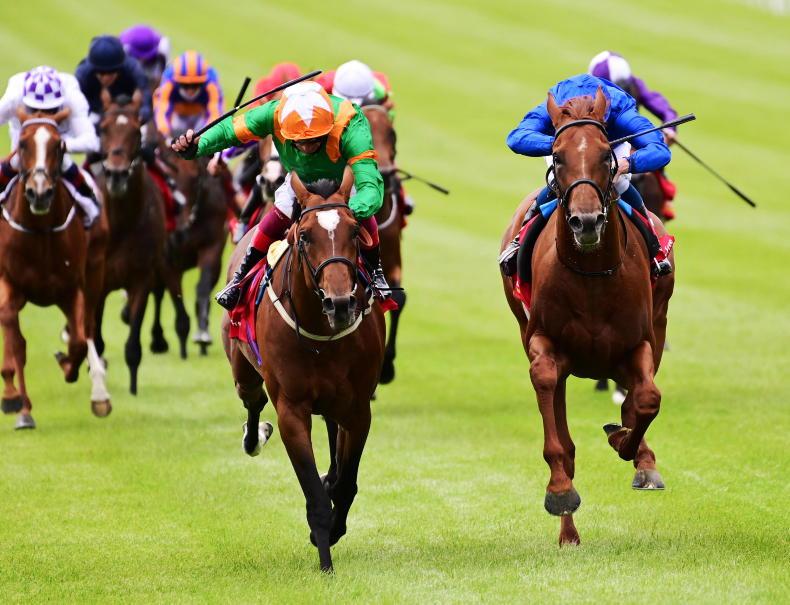THE Irish Derby is in need of a major overhaul.
It has been a dead man walking for a number of years, and only the generous sponsorship of Dubai Duty Free is giving it any sort of lustre.
In the last decade it has attracted a miserly 13 overseas challengers in total, a dozen from the UK and one from France. Three of those were last year and there were three in 2018, leaving a total of seven in eight runnings of the race in the past 10 years. Four of the 10 stagings had none at all.
This is supposed to be an aspirational race in the international calendar and it plainly is not.
Nowadays, outside of Ireland, the race is only ever ‘another race’ for those lucky enough to own a horse good enough, and to have had the foresight to have entered him before having a clue as to ability. This was not always the case.
Greats like Shergar, Grundy, Shirley Heights and Troy came straight to the Curragh in the seventies and eighties.
In the last decade Juddmonte have not had a runner, nor have the Niarchos Family, while Moyglare had one outsider 10 years ago. The Aga Khan of course won with Harzand, but his other two runners in the decade were Harzand’s pacemaker and a tailed off outsider.
Last year Godolphin brought their runner-up at Epsom rather than their winner. Absolutely their right to do so, and his subsequent victory proved them to be spot on, but it doesn’t give the marketing men much to hang their hat on. Come and see the second has not the same ring as come to see the champion.
As the third major Derby of the summer, the mystery has largely gone out of the middle-distance three-year-olds by then, so the storyline has to be about championship.
Ten furlongs
The solution is both simple and urgent. It needs to be shortened to 10 furlongs.
The days of the English and French Derby winners squaring up to decide Europe’s best three-year-old mile and a half colt in Co Kildare are but a distant memory. Generous beating Suave Dancer is the one that immediately springs to mind. The Epsom Derby winner beating the French Derby and subsequent Arc De Triomphe winner. It was a tremendous horse race and one that was easily marketable.
In 2005 the French, with approval from the European Pattern Committee, shortened their Derby to 10 and a half furlongs. Since then no winner of the French Derby has come on to the Curragh. Where would St Mark’s Basilica have run next after his win in the French Derby last year had the Curragh been a 10-furlong race?
The first instinct of the (non-Irish) winning owners of the Epsom Derby is to head to the Eclipse to ‘prove’ that their mile a half horse is really a mile and a quarter horse, and thus make him a more valuable stallion prospect. At 10 furlongs the Irish Derby becomes that race. A 10-furlong Irish Derby would also once again become the natural target for the French Derby winner.
Ipso facto game on and the winner is more than likely to be crowned European champion three-year-old middle-distance horse.
Natural fit
It would also be a natural fit for the Irish Guineas winner stepping up in trip, who currently has no options in Ireland until Champion Stakes weekend. Suddenly you have a race for horses stepping up, stepping down and proven 10-furlong performers. In other words, a race of intrigue which leads to more excitement for fans and opportunities for the gambling man.
There would be some consequences for the European Pattern (which also needs updating) by delaying the meeting of the mile and a quarter generations until the Juddmonte at York.
The Eclipse will suffer, but would still be an option. The mile and a half three-year-olds will have the King George VI and Queen Elizabeth Stakes and the Grand Prix de Paris as viable alternatives.
The bottom line, though, is that this is not about the pattern or the Eclipse, but about rescuing Ireland’s premier flat race from its steep slide towards irrelevance.
In the 1990s seven of the 10 winners were trained abroad. Afterwards the perfect storm of John Magnier, Sadler’s Wells and Aidan O’Brien made it a daunting prospect for foreign raiders as Ballydoyle came to dominate the mile and a half division. However, to continue to use this dominance as a passing phase from which the race will recover doesn’t wash anymore.
Changing times
We can rail against changing times, but the breed is shortening – whether we like it or not. For the record, I don’t.
The flat stallion men would rather milk cows than have a standalone winner of the Irish Derby, and this reflects back on to the value of said animal.
If you tell a new owner to the game that the winner of a six-furlong Group 1 or even Group 2 is worth considerably more than the winner of the Irish Derby, he or she will want one of those.
Ironically, the Irish Derby has actually produced five top-class stallions since 1999 with Montjeu, High Chaparral, Galileo, Camelot and Australia triumphant. All Sadler’s Wells-line horses, and all owned by Coolmore. They also would all have won the race had it been run over 10 furlongs.
Growing up in Kildare, the Irish Derby was a huge social event for both us locals and the great and the not-so-great of Dublin town.
Party buses would deliver well-dressed youth to enjoy a proper day of craic. You couldn’t move around the parade ring and the place rocked.
Now it barely registers. The crowd is less than half what it was 20 years ago. This is despite Irish racing enjoying the best national press and television coverage in the western hemisphere. No one is pretending that flat racing is as popular as it once was. The competition for the entertainment euro is now greater.
We have moved the timing of the race on numerous occasions to avoid clashing with more popular sports, which in itself is an admission of our position in the sporting hierarchy.
However, there are around two and a half million people in the greater Dublin area. I have no idea of the demographics of who might come to the Curragh, but aiming to attract a mere 15,000 from Dublin to add to a further 15,000 from the rest of the country does not seem to be putting the bar too high.
Razzmatazz
Surely we can persuade 30,000 people to go flat racing on its biggest occasion. Racing can still produce a glamour and razzmatazz that is not seen at any other sporting occasion. Maybe Bing Crosby won’t be singing in the parade ring, but a dressed-up crowd is the sole possession of the racing game. We know how to put on a show, but we need the main players to be on the stage.
We have just opened a magnificent new grandstand that deserves to be full on at least one day a year, and the Irish Derby is that day. To do that we need the best horses in Europe coming to the Curragh for a championship showdown. It is a major part of getting bums on seats, attracting sponsorship and growing television audience.
The only reason to maintain the status quo is to maintain the status quo. The father of the modern thoroughbred, Eclipse, never ran before he was five and never ran at less than three and a half miles. Imagine putting him to one of today’s stallion men. The world turns and the breed is ever evolving.
This is about one race only, and it is but one small step in the direction the breed has already gone. We would be followers not leaders.
Much more importantly though, it is about keeping the Irish Derby relevant both for us in the industry and racing fans throughout the country and beyond. We need them, along with every owner of a potential champion, to want to be at the Curragh at the end of June.
Shortening the race is not something that requires a lengthy debate, because the longer we debate the more difficult resurrection becomes and, unfortunately, it is a resurrection that is now required.


 This is a subscriber-only article
This is a subscriber-only article
 It looks like you're browsing in private mode
It looks like you're browsing in private mode











SHARING OPTIONS: